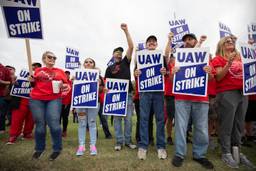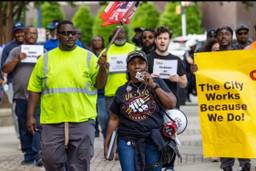A school shooting in Newtown, Conn. today at Sandy Hook Elementary School stunned the nation and left 27 dead. Among the victims were 20 children, as well as teachers and administrators.
The slain teachers were members of the Newtown Federation of Teachers Local 1727, a chapter of the American Federation of Teachers (AFT). The principal of the school, Dawn Hochsprung, who was killed in the attacks, was also an active member of the American Federation of School Administrators (AFSA). On its Facebook page, AFSA wrote:
We’ve just been informed that one of our sisters was killed in today’s unthinkable tragedy. Our thoughts and prayers go out to her family. Moving forward as school administrators, we must ensure that proper safety measures are put into place to protect our students, teachers, and principals.
Connecticut AFT spokesman Eric Bailey tells In These Times that AFT is currently working with unions across the country to coordinate grief counseling for the survivors of the shooting.
Homicide is now the third-largest cause of work-related deaths. According to the U.S. Bureau of Labor Statistics, it is the number one cause of death for women on the job.
Meanwhile, a new report released by the Center for Poverty Research and the Center for Health Care Policy Research at UC Davis says that workplace injuries and deaths to low-wage workers cost the US economy $39 billion a year. In a report for DefendingScience.org, J. Paul Leigh writes:
The paper reports on costs in 65 low-wage occupations for four classes of injury and illness: nonfatal injuries, nonfatal illnesses, fatal injuries, and fatal illnesses. I estimate 596 fatal injuries and 1,625,152 nonfatal ones, costing $441 million and $28.3 billion in 2010. For illnesses, the estimates are 12,415 fatal and 87,857 nonfatal cases, with costs of $8.77 billion and $1.53 billion. Seven low-wage occupations account for a substantial share of the injuries and illnesses, and the greatest total costs: retail salespersons ($4.5 billion); janitors and cleaners ($4.1 billion); maids and housekeeping cleaners ($3.1 billion); stock clerks and order fillers ($2.7 billion); food preparation and serving workers ($2.1 billion); restaurant cooks ($1.8 billion); and cashiers ($1.8 billion).
These estimates suggest that workers in low-wage occupations contribute significantly more medical and productivity costs than is generally assumed.
A draft of the new Egyptian Constitution would limit the independence of trade unions and roll back portions of Egypt’s landmark 1976 trade union law. From The Cairo Review:
On the heels of the now hotly contested decree granting the Egyptian president unlimited authority, President Mohammed Morsi also amended the nation’s 1976 trade union law. Egypt’s independent labor movement opposes the amendment, saying it signals potential suppression of the right to freely form unions while providing Morsi’s administration with the power to bypass democratic union elections by appointing new board members of the Egyptian Trade Union Federation (ETUF), which has always been closely aligned with the state. The government’s acts have raised concerns for Egypt’s democratic transition, causing thousands of citizens to return to the streets in mass demonstrations. This amendment leaves intact “ETUF’s legal monopoly on trade union organization.”
“Morsi is clearly preparing a systematic crackdown against Egypt’s union movement, against the right to strike, against the right to organize and against union plurality,” says Fatma Ramadan, an executive board member of the Egyptian Federation of Independent Trade Unions (EFITU). The EFITU and the Egyptian Democratic Labor Congress (EDLC) have released statements regarding the amendment.
Law 97 of 2012 amends Egypt’s 1976 trade union law by:
- Imposing an age limit on union membership, restricting it to people age 60 and younger.
- Giving the government the authority to fill all seats left vacant for any reason on the executive boards of the ETUF and its affiliated unions.
A group of federal judges are suing the federal government to get back promised back pay. From AP:
The U.S. Court of Appeals for the Federal Circuit in October ordered Congress to pay six federal judges years of back pay. Now a group of federal judges is pushing a class-action lawsuit to ensure all of the rest of the federal judges who also missed out on their cost-of-living increases get what they feel is their due.
It’s a touchy subject: One set of federal judges asking another set to essentially approve salary increases for everyone. Though, of course, Congress also ultimately controls its own salaries.
Congress in 1989 limited federal judges’ ability to earn money outside of their work on the bench and in exchange provided what was supposed to be automatic cost-of-living increases to judicial salaries to ensure inflation wouldn’t erode the value of those salaries over time.
U.S. District Judge Royal Furgeson Jr. of Texas, one of the judges seeking class-action status, called that a “binding commitment” made by the legislative branch for the judicial branch to “receive the same yearly COLAs awarded to all other federal employees, to keep us even with inflation.”
But instead of following through, Congress withheld those cost-of-living increases in 1995, 1996, 1997, 1999, 2007 and 2010, while giving other federal employees their promised increases. “In our view, the exclusion is contrary to the commitment to us, so we have sued to enforce it,” said Furgeson, a senior judge who also serves as the president of the Federal Judges Association.
In a must-read expose in the Nation, Lee Fang reveals how the groundwork was laid for the right-to-work legislation in Michigan. From The Nation:
These organizations [i.e. Americans for Prosperity and the Mackinac Center] are part of a more aggressive political force that is adept at controlling the twenty-four-hour news cycle and managing coalitions. Unlike ordinary business lobbies that simply support right-to-work, these advocacy groups go out and shape public opinion through broad messaging and content development, which in turn is used for organizing around policies.
Both AFP and the Mackinac Center are backed financially by the billionaire DeVos family, which has sought to control public policy debates through state-level nonprofits. Donors Trust, the nonprofit foundation used by wealthy conservative donors to anonymously finance activism on the right, has heavily funded AFP and Mackinac in the last three years. Doug DeVos chairs a nonprofit that has mobilized influential executives in the state to support right to work in Michigan.
The model isn’t new. In Wisconsin, Governor Scott Walker (R-WI) relied heavily on Americans for Prosperity Wisconsin and a state-based think tank called the MacIver Institute to build political support for his effort to curtail union rights. In Ohio, Governor John Kasich (R-OH) worked closely with another business-backed group, the Buckeye Institute, for his attempt to crush local unions.
A federal judge has ordered a nursing home in Connecticut to reinstate 600 striking nurses and to rescind the benefits cuts that it imposed on the workers. From The New York Times:
Judge Robert N. Chatigny of the United States District Court in Connecticut ruled on Tuesday night that the nursing homes’ owner, HealthBridge Management, had broken the law by refusing to bargain in good faith and by imposing the cuts before a true negotiating impasse had been reached.
Judge Chatigny issued an injunction that ordered HealthBridge to reinstate the workers by next Monday, even if it means ousting hundreds of the replacement workers hired to run the nursing homes after the strike began.
“Everybody is quite happy about the decision,” said Vern Scatliffe, a nurse’s aide, as he picketed outside Danbury Health Care Center, one of the five nursing homes — the others are in Milford, Newington, Stamford and Westport — where the workers walked out to protest the cuts HealthBridge had imposed. “The judge’s order is a big relief to me. I can now go back to work and earn my living again.”
All of the staff at In These Times extends our sincerest condolences to the families of the Sandy Hook Elementary shooting victims.

I hope you found this article important. Before you leave, I want to ask you to consider supporting our work with a donation. In These Times needs readers like you to help sustain our mission. We don’t depend on—or want—corporate advertising or deep-pocketed billionaires to fund our journalism. We’re supported by you, the reader, so we can focus on covering the issues that matter most to the progressive movement without fear or compromise.
Our work isn’t hidden behind a paywall because of people like you who support our journalism. We want to keep it that way. If you value the work we do and the movements we cover, please consider donating to In These Times.








